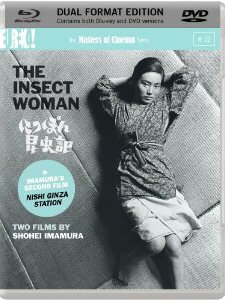
"My heroines are true to life - just look around you at Japanese women. They are strong, and they outlive men". The words of late, genial Japanese filmmaker Shohei Imamura in an interview of old.
And for a perfect example of this ethic, look no further than these two early Nikkatsu films from the great man.
THE INSECT WOMAN (a.k.a. NIPPON KONCHUKI) is the later of the two, having first been released in 1963. But, seeing as though it’s the film being used to sell this release, we’ll take a look at that first.
It starts off in typically striking fashion, merging stunning footage of an insect crawling across rough terrain with a mournful female vocal asking where the babysitter has gone.
Then we get snow as we’re thrust into Japan in the middle of a very harsh winter in the early part of the 20th Century. A poverty-stricken family gather in their humble abode for the birth of their latest child: Tome.
And it’s Tome, born to unmarried parents and raised by their askew moral codes, that the film will ultimately scrutinise. It follows one vignette after another as we trace her life and travails throughout the decades, right up to the birth of her own granddaughter many moons later.
In-between, we get inter-family bickering, squalor, minor bouts of happiness, love, regret, factory working, war, childbirth and – in a taboo-trashing nod for its era – prostitution.
Some of the leaps in passages of time are quantum (shifting from 1924 to 1942 within the space of 5 minutes seemed brisk) but, overall, Imamura’s method works and we realise that this is the talent of a skilled storyteller: what may seem ill-advised at first glance gradually gives way to a better sense of drama, and an emotional core that centres more on one timescale during the film’s second half.
The title is never explained but is thought to suggest that Tome (portrayed for the bulk of the film by the warm, effortlessly charming Sachiko Hidari), and women in general, have the strength, diligence and endurance that insects are famous for. And that certainly comes across in this oddly engrossing, arty and yet soapy epic.
Perfect performances and gorgeously realised compositions make this a film enthusiast’s pleasure from beginning to end. The big bonus is that the film has a massive heart, making it one of the more emotionally resonant of Imamura’s works.
Just ignore the infrequent attempts at comedy ...
NISHI-GINZA STATION (a.k.a. NISHI-GINZA EKIMAE) hails from 1958 and has a lighter, if no less taboo for its time, tone.
The film tells of a married couple who work at the station and banter amiably as life hurriedly passes them by. The husband in particular is a dreamer, and the film flits playfully between a documentarian sense of reality and more kitsch fantasy sequences.
Well-shot and arguably pioneering for its time (the film is punctuated by on-screen and story-relevant songs from Frank Nagai, a la THERE’S SOMETHING ABOUT MARY), STATION is a lesser Imamura film – but still worthwhile.
In short, both films are filled with the invention and playful bastardisation of cinematic conventions that Imamura became renowned for throughout his startling career. Moments of humour are (mostly) played in a satisfyingly subtle manner, while transgressive subjects creep into universal themes and vice versa, illuminating both the heart and brain at work here.
Eureka’s blu-ray disc comes as part of their well-regarded Masters of Cinema series, and is up to their usual high standards.
INSECT WOMAN and NISHI-GINZA STATION are both presented in their original aspect ratios of 2.35:1 and 16x9 enhanced in well contrasted, solid 1080p VC-MPEG4 presentations. Blacks are remarkably well handled in all manner of shades while brightness impresses in a natural way, allowing for detailed pictures without unwelcoming screen flicker. Both films were shot on 35mm and the stock used here has fared well over the years, minor specks notwithstanding. Natural film grain is light but evident in both cases, demonstrating a restraint applied to the use of DNR. INSECT WOMAN is the slightly clearer, sharper transfer of the two – but both impress.
Original Japanese audio for each film comes in the original 2.0 mix, remastered in nice Master Audio mixes. Optional English subtitles are well-written and easy to read.
A static main menu page offers access to static scene-selection sub-menus (16 chapters for WOMAN; 7 for STATION), and the opportunity to disable the aforementioned subtitles.
The only on-disc extra is a 21-minute archive video interview with Imamura, conducted by film critic Sato Tadao. This is an enlightening, easy watch and covers INSECT WOMAN along with other early works of his. This feature is window-boxed with Japanese audio and optional English subtitles.
The package is rounded off with another of Eureka’s excellent accompanying booklets. This one here is 36 pages long and benefits enormously from two informative, engaging essays – one on each film – from Japanese film expert Tony Rayns. Punctuated by attractive monochrome stills throughout, these are wonderful notes for wonderful films. However, Rayns’ undeniably intelligent philosophising on INSECT WOMAN can be somewhat abbreviated to the final three words of his essay: "it’s a masterpiece".
Another fantastic blu-ray set (actually it’s a dual format edition, also featuring a DVD with identical content – only the blu-ray was available to review) from Eureka, then, worthy if its place alongside other Imamura gems of theirs such as VENGEANCE IS MINE, THE BALLAD OF NARAYAMA and PROFOUND DESIRES OF THE GODS.
Recommended.
Review by Stuart Willis
| Released by Eureka Entertainment |
| Region 2 - PAL |
| Rated 18 |
| Extras : |
| see main review |